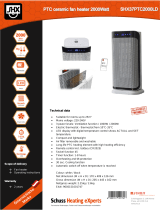
3
SAFETY INSTRUCTIONS
Important!
• Carefully read the instructions before operating the unit
• This appliance comprises of three indoor units and an outdoor unit. The slim wall mounted
evaporators are designed exclusively for indoor installations while the external condenser
should be installed outside, ensuring it is kept away from flood water or snow lines.
• Rating: This unit must be only connected to a 220-240 V / 50 Hz earthed power source.
• Installation must be in accordance with the regulations of the country where the unit is used.
• These air conditioners are supplied with refrigeration pipes and electrical cables. European
Union regulations requires for an F-Gas trained engineer to handle any operation where
non-qualified intervention could case fluorinated gas to escape. A commissioning certificate
must be issued with any installation.
• If you are in any doubt about the suitability of your electrical supply have it checked and, if
necessary, modified by a qualified electrician.
• This air conditioner has been tested and is safe to use. However, as with any electrical
appliance - use it with care.
• Disconnect the power before dismantling, assembling or cleaning.
• Avoid touching any moving parts within the appliance.
• Never insert fingers, pencils or any other objects through the guard
• This appliance is not intended for use by persons (including children) with reduced physical,
sensory or mental capabilities. It is also not intended for use by those with a lack of
experience and knowledge, unless they have been given supervision or instruction
concerning the use of the appliance by a person responsible for their safety. Do not leave
children unsupervised with this appliance.
• Do not clean the unit by spraying it or immersing it in water.
• Never connect the unit to an electrical outlet using an extension cord. The outdoor must be
hardwired by a qualified electrician.
• Never operate this appliance if the cord is damaged. Ensure the power cord is not stretched
or exposed to sharp objects or edges.
• A damaged supply cord should be replaced by the manufacturer or a qualified electrician in
order to avoid a hazard.
• Any service other than regular cleaning or filter replacement should be performed by an
authorized service representative or a qualified air conditioning engineer. Failure to comply
could result in a voided warranty.
• Do not use the appliance for any purpose other than its intended use.
• The outdoor part of the air conditioner unit must always be stored and transported upright,
otherwise irreparable damage may be caused to the compressor; if in doubt we suggest
waiting at least 24 hours before starting the unit.
• Avoid restarting the air conditioning unit unless 3 minutes have passed since being turned
off. This prevents damage to the compressor.
• Never use the mains as a switch to start and stop the air conditioning unit. Use the provided
ON/OFF button located on the remote control.
• Always place the unit on a dry and stable surface. Install the outdoor unit on a wall using
wall mounting brackets or fix to a floor slab with special floor mounting fittings away from
flood or snow lines.
• The indoor unit should not be installed in damp environments such as laundry or wet rooms




















